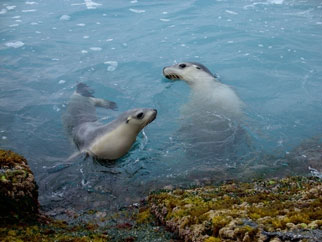
Australian sea lions, Neophoca cinerea
(© Brad Page - SARDI Aquatic Sciences)
Note: In this context, the generic term “seal or seals” includes the Australian sea lion (Neophoca cinerea) and all other seal species, but primarily the Australian fur seal (Arctocephalus pusillus doriferus) and the long-nosed (formerly New Zealand) fur seal (A. forsteri) found in Australian waters. Two seal species that visit and occasionally breed on the southern coasts of the continent – leopard seal (Hydrurga leptonyx) and elephant seal (Mirounga leonine) – are not included, but may also interact with human activity associated with Tasmanian salmonid farms.
In 2003, the Marine and Coastal Committee of the Natural Resource Management Ministerial Council (NRMMC) established an inter-government working group, the National Seal Strategy Group (NSSG), to initiate a coordinated national approach to managing human-seal interactions.
In consultation with relevant stakeholders, the NSSG developed the National Strategy to address interactions between humans and seals - Fisheries, aquaculture and tourism (National Seal Strategy). The National Seal Strategy aimed to assist the commercial fishing, aquaculture and tourism sectors to understand legislation protecting seals in Australian waters, and guide industry efforts to reduce any adverse impacts on seals while maintaining the economic and ecological sustainability of those industries.
The development of the strategy was supported by a comprehensive scientific background document, the National assessment of interactions between humans and seals - Fisheries, aquaculture and tourism.
A summary document Managing interactions between humans and seals is available for stakeholders who wish to quickly understand the science behind the National Seal Strategy as a basis for decision-making.
The Australian Fisheries Management Authority (AFMA) released the Australian Sea Lion Management Strategy on 29 June 2010. This strategy was developed to reduce and monitor interactions between Australian sealions and gillnets used by Commonwealth shark fishers in the Southern and Eastern Scalefish and Shark Fishery. Copies of the Strategy can be obtained from AFMA.
For more information on the conservation status of Australian seals and sea lions visit the seal and sea lion page on the Department of the Environment website.
